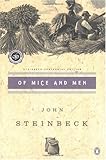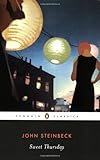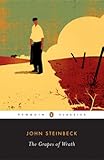|
Editorial Review Product Description
This third volume in The Library of America's authoritative edition of John Steinbeck's writings shows one of America's most enduring popular writers continuing restlessly to explore new subject matter and new approaches to storytelling.
The Moon Is Down (1942), set in an unnamed Scandinavian country under German occupation, dramatizes the transformation of ordinary life under totalitarian rule and the underground struggle against the Nazi invaders.In Cannery Row (1945) Steinbeck paid tribute to his closest friend, the marine biologist Ed Ricketts, in the central character of Doc, proprietor of the Western Biological Laboratory and spiritual and financial mainstay of a cast of philosophical drifters and hangers-on. The comic and bawdy evocation of the main street of Monterey's sardine-canning district has made this one of the most popular of all Steinbeck's novels. Steinbeck's long involvement with Mexican culture is distilled in The Pearl (1947). Expanding on an anecdote he had heard about a boy who found a pearl of unusual size, Steinbeck turned it into an allegory of the corrupting influence of sudden wealth. The Pearl appears here with the original illustrations by José Clemente Orozco.
Ambitious in scale and original in structure, East of Eden (1952) recounts the violent and emotionally turbulent history of a Salinas Valley family through several generations. Drawing on Biblical parallels, East of Eden is an epic that explores the writer's deepest and most anguished concerns within a landscape that for him had mythic resonance. ... Read more Customer Reviews (5)  Best Collection of Steinbeck Novels
Best Collection of Steinbeck Novels
The Library of America editions are a great way to own a Collection of novels from a great writer; The compact hardbound edition has a dust jacket and is a nice addition to your bookshelves; and these particular Steinbeck novels can be read over and over:
The Moon Is Down / Cannery Row / The Pearl / East of Eden
 Steinbeck is Amazing...All of it
Steinbeck is Amazing...All of it
This volume is just as impressive as the other volumes in the Library of America collection.
 Reading Steinbeck
Reading Steinbeck
I hadn't read John Steinbeck since high school, but I returned to him about a year ago after our book group read his late novel, "The Winter of our Discontent".I was pleased to read this collection of Steinbeck's novels, written from 1942 -- 1952,in the Library of America series.They are of varied lengths, varying settings, and varied themes.Yet they show a writer with a broad continuity of themes including people, the land, American values, human sexuality, the importance of culture and education, and much else. It may be useful to explore some of the threads among the novels collected in this volume.
Steinbeck wrote his short novel "The Moon is Down" in 1941 following a request by the Foreign Information Service to assist American propaganda efforts during WW II.The story is set in an unnamed Scandanavian country which, when the book opens, has been invaded by Germany.Although the book is short, the characterizations are diverse and effective as Steinbeck gives the reader portraits of the German office corps, and of the people of the town, including the mayor, a collaborator with the enemy, and a young woman, Molly, whose husband has been shot by the invaders.I particularly enjoyed the use Steinbeck made of the products of human creativity and thought in his story which emphasizes the priceless nature of human freedom.Thus, the climactic scene of the story includes a discussion of Plato's Apology among the mayor, his friend, and the German commander.Another critical scene in the book turns on the love poetry of the German poet Heinrich Heine.In this novel, Steinbeck met the aims of the Foreign Information Service, but more importantly he produced a defense of human liberty that far transcended these aims.
In the next book in this collection, Cannery Row,(1944) Steinbeck deliberately avoided the war. He claimed that he wrote the book as "a kind of nostalgic thing ... for a group of soldiers who had said to me: 'Write something funny that isn't about the war.Write something for us to read -- we're sick of war."
The book is set in Steinbeck's beloved Monterey, California during the depression.The main character in the book, Doc, is modeled on Steinbeck's friend Ed Ricketts, a marine biologist.Doc befriends a group of Cannery Row denizens of the local flophouse -- headed by a character named Mack -- and the relationship between Doc and the "Palace Flophouse" residents forms the basis for most of the scenes in this book.Other characters include Dora, the madam of the Bear Flag Restaurant who is sympathetically portrayed.As we will see, Steinbeck portrayed madams in other books with a much harsher view.I was surprised to find in this book a discussion of an ancient Sanskrit love poem, "Black Marigolds" together with discussions by Doc of Monteverdi, Bach, Beethoven and Debussy. The importance Steinbeck attached to high products of human thought and creativity is sometimes overlooked.
The third novel in this collection is the brief work, "The Pearl" (1947) which, unfortunately, has become the bane of many young readers who have the work forced upon them.Both the book and the readers deserve a better fate.The book takes place in Mexico and is a story that shows the effect upon a poor family of discovering a pearl of great wealth.It is simply and eloquently told.Steinbeck describes his book as "a parable" in which "perhaps everyone takes his own meaning from it and reads his own life into it."The book makes great use of song imagery as we are told at the outset that the people of the Mexican village "had been great makers of songs so that everything they saw or thought or did or heard became a song."The main character, Kino, hears in his heart various songs throughout the book, the most important of which is the "Song of the Family" or the "Whole" which celebrates his life with his wife and new baby. This is a short, beautiful story which glows with the many colors and ambiguities as did the pearl which Kino discovers.
The final novel in this collection, and the longest by far is "East of Eden" which Steinbeck wrote in a burst of energy in 1951.This was Steinbeck's favorite among all his works and he literally put himself into it in the person of the narrator.
Steinbeck said that he wrote "East of Eden" to tell "the story of my country and the story of me" to his two young sons in order to demonstrate "the greatest story of all -- the story of good and evil, of strength and weakness, of love and hate, of beauty and ugliness, how these doubles are inseparable."For all its melodrama, length, sometimes black-and-white characterizations, and preachiness, the novel achieves its goals.I was transfixed by the book.
Most of the story takes place in the Salinas Valley of Northern California and involves the saga of two families, the Hamiltons and the Trasks.There are two Trask brothers, Adam and Charles, and twin sons of Adam, (presumably), and his wife Cathy -- Aron and Caleb. Both Adam and Charles and Aron and Caleb replicate in their own ways the Biblical story of Cain and Abel.Steinbeck gives this story a full biblical style exegisis as the reader sees the story of the conflict between good and evil play out in double over the course of the book.
This book features another madam, Kate -- or Cathy Trask whom Steinbeck describes as a "monster".This is a far different woman than the Dora of "Cannery Row".
This book portrays strikingly the good and evil of which people are capable and their capacity to make choices -- to understand the good and reject the evil.Steinbeck writes in a humanistic rather than in a theological way.
In summary, this volume includes four different yet related works by an outstanding American author.This book will reward reading by those who wish to explore some of the great literature that has been written in the United States.The Library of America deserves gratitude for making our country's literary and cultural achievements available to many readers.
 A Nobel Laureate's Eden and Our Many Faults and Failures.
A Nobel Laureate's Eden and Our Many Faults and Failures.
Whenever "the great American novel" comes up in conversation, the names most frequently bandied about are Fitzgerald ("The Great Gatsby"), Faulkner ("The Sound and the Fury"), Hemingway ("The Old Man and the Sea") - and John Steinbeck, chronicler of rural California and the ordinary man's plight, like Faulkner and Hemingway winner of both the Literature Nobel Prize (1962) and the Pulitzer (1940, for "The Grapes of Wrath"), in addition to multiple other distinctions.
Little in Steinbeck's upbringing hinted at his future rise to fame.Born 1902, a modest Salinas, California, flour-mill-manager-turned-county-treasurer's son, he worked as a farm-hand during high school and studied English and biology at Stanford, but left 1925 without graduating to pursue journalism and writing in New York; only to have to return home a year later.Surviving on a number of odd jobs, he continued to write.His first novel, 1929's "A Cup of Gold," however, failed to return his publisher's $250 advance, and his subsequent collection of interrelated stories ("The Pastures of Heaven," 1932) and novel ("To a God Unknown," 1933) likewise remained largely unknown.Steinbeck's fate changed with 1935's humorous "Tortilla Flat," chronicling life in a Chicano community (and an allegory on Steinbeck's own first literary influence, the Arthurian legend, to which he returned much later in an unfinished attempt to modernize Mallory's "Morte D'Arthur").Both "Tortilla Flat" and the subsequent "In Dubious Battle" (1936) - Steinbeck's first exploration of the California's migratory workers' fate - won the California Commonwealth Club's Gold Medal; and the sale of "Tortilla Flat"'s movie rights earned him his first truly big check.Steinbeck's reputation grew further with the interrelated coming-of-age stories of "The Red Pony" (1937), and his next two novels, 1937's poignant "Of Mice and Men" and, particularly, "The Grapes of Wrath" (1939), the story of angry "harvest gypsy" Tom Joad and his family.Both works are still among America's 35 books most frequently banned from school curricula:keen testimony to the nerves they continue to touch.
Steinbeck's major works are collected in (to date?!) three volumes of the Library of America series, the first covering his 1932 - 1937 writings, the second "The Grapes of Wrath," Steinbeck's extensive background research ("Harvest Gypsies," 1936), the short story collection "The Long Valley" (1938) and his contribution to "The Sea of Cortez," a 1941 publication about his 1940 marine exploration with close friend Ed Ricketts.The present - third - volume contains three works from the 1940s, in addition to the awe-inspiring "East of Eden;" thus omitting the 1942 and 1948 nonfiction accounts "Bombs Away" and "A Russian Journal," the 1947 character study "The Wayward Bus" and the 1950 play-novelette "Burning Bright".
"The Moon Is Down" (1942) reflects Steinbeck's impressions upon hearing the testimony of refugees from Nazi-occupied Europe.Originally conceived as a play set in the U.S. but revised as a novel set in an unnamed Scandinavian country, it describes the struggle of a group of underground fighters in an occupied society.Widely read in occupied Europe, in 1946 it won Norway's King Haakon Liberty Cross.
"Cannery Row" (written 1944, published a year later) was a response to a group of soldiers' request to Steinbeck to write "something funny that isn't about war."It revolves around Doc Burton, a literary incarnation of the author's friend Ed Ricketts, first introduced as a supporting character in "In Dubious Battle" and now taking center stage as a man whose mind has "no horizon," and his sympathy "no warp."(The novel's dedication reads: "For Ed Ricketts who knows why or should.") - Steinbeck returned to Doc and his Monterey community in 1954's "Sweet Thursday."
"The Pearl," the folklore-based story of a boy whose life is altered (not for the better) by the discovery of a precious pearl, began as a screenplay for a film directed by Mexican Emilio Fernandez.The novel's publication was postponed to coincide with the movie's early 1948 release; by this time the story had, however, already appeared in a magazine.
"East of Eden," by far the longest work contained herein, was, according to Steinbeck himself, *the* major novel of his life: "I think there is only one book to a man," he noted in a letter to his publisher.Of epic scope and breathtaking craftsmanship and complex characters, it is part chronicle of California's early settlement, part family saga and part tale of two unequal brothers' rivalry, modeled on the bible's Cain and Abel.Intending the book primarily for his sons, Steinbeck commented that it was like a box containing "[n]early everything I have ... [p]ain and excitement ... evil thoughts and good thoughts - the pleasure of design and some despair and the indescribable joy of creation."The writing process was accompanied by a series of letters to Steinbeck's publisher, published 1969 as "Journal of a Novel: The East of Eden Letters."
In his remaining 16 years, Steinbeck published only three more works of fiction - besides "Sweet Thursday," the satirical "Short Reign of Pippin IV" (1957) and 1961's swan-song on materialism, "The Winter of Our Discontent."(The uncompleted "Acts of King Arthur and His Noble Knights" was published posthumously.)His most popular later work is the journal of his trans-American road trip with his poodle Charley ("Travels With Charley," 1962).But he remained a critical voice, released several collections of journalism and when he died, left a legacy also including a treasury of letters and two highly-acclaimed screenplays, for an adaptation of his own "Red Pony" and for 1952's "Viva Zapata!" (starring Marlon Brando and Anthony Quinn), in addition to screen versions of his novels involving Hollywood luminaries from John Ford and Elia Kazan to Henry Fonda, James Dean, Spencer Tracy, Robert Mitchum and, more recently, Gary Sinise and John Malkovich.
"The ancient commission of the writer has not changed. He is charged with exposing our many grievous faults and failures, with dredging up to the light our dark and dangerous dreams for the purpose of improvement." - John Steinbeck, Nobel Prize Acceptance Speech (1962).
Also recommended:
John Steinbeck : Novels and Stories, 1932-1937 : The Pastures of Heaven / To a God Unknown / Tortilla Flat / In Dubious Battle / Of Mice and Men (Library of America)
John Steinbeck: The Grapes of Wrath and Other Writings 1936-1941: The Grapes of Wrath, The Harvest Gypsies, The Long Valley, The Log from the Sea of Cortez (Library of America)
John Steinbeck: Travels with Charley and Later Novels 1947-1962: The Wayward Bus / Burning Bright / Sweet Thursday / The Winter of Our Discontent (Library of America)
The Acts of King Arthur and His Noble Knights: (Penguin Classics Deluxe Edition) (Penguin Classics Deluxe Edition)
America and Americans and Selected Nonfiction (Penguin Classics)
John Steinbeck, Writer: A Biography
The Grapes of Wrath
East of Eden (Two-Disc Special Edition)
Of Mice & Men
Viva Zapata!
 Thanks, Library of America!
Thanks, Library of America!
It's great to see Steinbeck's works coming out in this nice edition. This volume is up to LOA's usual excellent standards, and like the first two volumes in the Steinbeck series, continues covering both famous pieces like Cannery Row and East of Eden, as well as some of his less known works. In any case it's a real treat for any Steinbeck fan. Can't wait for the fourth volume!
... Read more
|

















